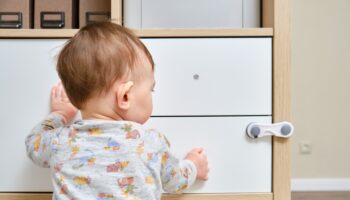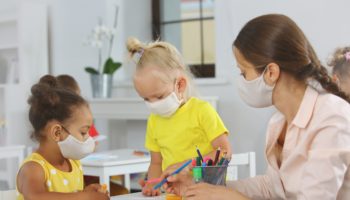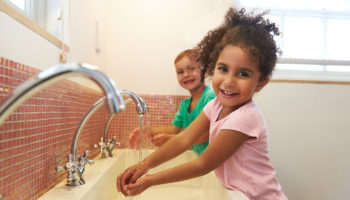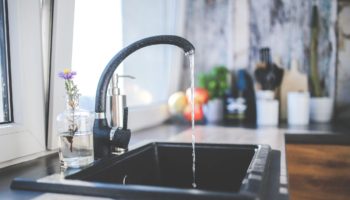Does changing a diaper seem daunting with all those steps that are needed? You may have been overwhelmed seeing those steps listed. The procedural steps that the Program Quality Assessment team follows was a collaboration between the authors of the Environment Rating Scales, The American Academy of Pediatric resource “Caring for Our Children” and our Department of Human Services here in Pennsylvania.
We can simplify the procedure with some mental notes about what to do in changing a diaper and why certain steps are part of the procedure. We can mentally think of the list as 4 easier to remember phases.
First the PREPARATION phase:
What do I need to prepare to do this phase well? Bring to the changing table or mat a new diaper, wipes, creams, and a second set of clothes (if you think you will need them for a particular change). To prepare take out one clean diaper, enough wipes for the change as well as a few extra, and squeeze creams onto a cloth (if child needs this). Put the tube of cream and the diaper wipe container away before the change.
Why is this phase necessary? Everything you do for this set of steps is done before a child is placed on the changing table. Preparation is what you do to get ready, so the child doesn’t have to wait or fidget as you get supplies ready. To keep wipes containers and tubes of cream clean from contamination, put them away before you get the child.
Second is the CONTAMINATION REMOVAL phase:
What do I need to do to complete this phase well? Place the child on the changing table and remove clothing to access diaper keeping the clothing out of the contaminated area. Never leave the child unattended on a changing table or countertop. If clothing is soiled place in a plastic bag to send home. Unfasten the diaper leaving it under the child. Use wipes to clean child’s bottom from front to back and place inside the soiled diaper or directly into a plastic lined, hands-free covered trash can. Use each wipe for only one swipe. Fold the soiled surface of the diaper inward over the used wipes and place the bundle in the trash can. If gloves were used discard them at this time into the same trash can. Do not put a disposable soiled diaper into a plastic bag but put it immediately into a plastic lined hands-free trash can. (Cloth diapers that are reusable are to be put immediately in a plastic bag; do not take the diaper to flush solid contents down the toilet.)
Why is everything in this phase necessary? This second set of steps involves cleaning the child and throwing away everything that has contamination on it. Dirty gloves, diapers and wipes are all to be discarded before anything clean is touched (clothes, new diaper, etc.). Soiled clothing and cloth diapers are to be put into a plastic bag because it is non-porous and taken home to be laundered. Disposable diapers, wipes, and contaminated gloves are to be immediately discarded after wiping the child in a plastic lined, hands-free trash can to lessen the likelihood that children touch them, or they touch clothing as the fresh diaper and clothing are put onto the child. Disposable diapers are not to be individually bagged because overhandling of the soiled diaper is more likely to spread contamination. When using wipes, wiping from front to back is a more sanitary way to ensure bodily fluids are not pushed onto or into other parts of the body. Using only one wipe per swipe removes contamination more effectively while using the wipe for more than one swipe spreads contamination.
Third is a TRANSITION phase:
What do I need to do during this phase to get ready for the clean phase? Use a wipe to remove soil from your hands and throw it in the trash can. Use another wipe to remove soil from the child’s hands and throw it in the trash can.
Why do I need to do this? To transition from the dirty step to the clean step, removing germs from the hands is a good practice. Even if gloves are worn, it is a good practice before touching a child’s clean diaper and clothing to remove some germs from your hands. Also, it is largely possible and often likely that a child has explored their body during the changing and their hands are likely to contain germs from urine or feces.
Fourth is the CLEAN phase:
What do I need to do during this phase? If paper liner was used, check for soil under the child and fold paper up from the child’s feet to cover the area and create a clean surface under child’s bottom. Put on the clean diaper and diaper cream if needed and redress the child. Wash the child’s hands and return them to the group without touching other surfaces. Store bagged, soiled clothing for parents in an area inaccessible to children. Dispose of paper liner in the trash can if used. Clean visible soil from the changing table and disinfect the surface with bleach/water solution or an EPA approved product according to directions. Finally, the individual who changed the child’s diaper needs to wash their hands.
Why is this phase important? All the steps in this phase happen after contaminated items such as the soiled diaper and wipes are removed from the changing surface. This will help to ensure that as you are redressing the child, their clothes and body do not come into contact with these contaminated items.




